Displaying items by tag: Compliments to the Chef, Paula and John Reardon
Pop on Over
Hello my Foodie Friends!
Many of our foodies may be traveling to visit family or friends this weekend, or may be hosting a holiday breakfast or dinner. Often times we are not sure what to bring to add to the meal that is being made. One item that is always welcomed is Popovers.
Most people fall into a rut when it comes to bread options. However, Popovers can be a deceptively simple item that will impress your guests and tickle their taste buds. Not only are popovers cost effective, they’re also a breeze to make as long as you follow a few simple rules: make sure the pan is hot before pouring in the batter, don’t fill the cups more than half full, and no opening the oven while they’re baking.
Having the correct pan is important to making airy popovers with golden domes. The secret is how the batter lies in the pan. Popover pans are used for making popovers. They are specially constructed to convey the heat directly to the batter, which needs to be added to a hot pan, similar to the way Yorkshire puddings are made. Popover pans are also made with tall, narrow cups, which create a distinctive shape. This creates steam that helps the popovers expand and become light and hollow on the inside. Then you can stuff them with things. A popover pan is deep with steep-sided wells. This forces the batter upwards creating puffy domes and crispy sides. Investing in a real popover pan eventually starts to feel quite justifiable. These tins are really only useful for making popovers, but oh, what beautiful popovers they make! The trick is to make sure the pan is very hot before you add the butter and the batter.
At Compliments to the Chef, we carry popover pans from Nordicware and USA Pan. Both the Nordicware pan and USA Pans are made in the U.S.A. These pans are designed to allow maximum airflow so popovers reach their full height.
The next time you are not sure what to pop on over with to visit a friend or a family member, think about a creative popover to serve with the meal. Come visit your neighborhood kitchen and cutlery store located at 33 Railroad Place, where we have cool tools for cooks! Have fun with family and friends. Remember, “Life Happens in the Kitchen.”
Take Care,
John & Paula

Sous Vide: So Good!
Hello my Foodie Friends!
Being part of downtown Saratoga offers us the ability to serve not only our home chefs, but to also work with the incredible professional chefs from our area restaurants. A tool that is often asked for is the Sous Vide immersion blender. Sous vide (it’s pronounced soo-veed) sounds like a term that famous chefs would throw around—and it is. Fancy kitchen professionals have been using the sous vide cooking technique for years, primarily because it cooks meat and fish more evenly than any other method and retains vegetables’ color, flavor, and nutrients in a way steaming never could. What on earth is it, though? Sous vide is a technique that involves sealing meat or veggies in an air-tight bag (sous vide means “under vacuum” in French), then submerging and cooking them in a temperature-controlled water bath. Sous-vide cooking lets you control the final temperature of your food exactly, making overcooked food virtually extinct. Unlike cooking food in the oven or grill—which heats foods much higher than their target temperatures—leaving your steak in a sous-vide bath an extra 1o minutes or so isn’t going to take it from medium-rare to well-done. It’s also an extremely moist cooking environment, as nothing is going to evaporate from a vacuum-sealed bag—meaning dry, drab pork chops are a thing of yesteryear. Best of all, it’s super easy. Just pick your target temperature, seal your meat in a bag, and set it in the bath. Set a timer and, once your meat is cooked to your desired “doneness,” pull it out, pat it off with paper towels, and give it a hot sear.
The All-Clad Sous Vide Immersion Blender. The All Clad Sous Vide cooking technique matches with the brand’s heritage, focusing on uncompromising performance and quality results that professional chefs expect. The All-Clad Sous Vide Immersion Circulator allows you to create perfectly cooked, and juicy results that are never overcooked. The thermal circulator continuously pumps water at programmed temperature to ensure consistent cooking temperatures set with .1 degree accuracy. The sous vide circulator offers a professional style precise temperate control with a quiet and compact design for the ultimate cooking experience. The unit’s adjustable clamp allows you to secure your circulator to whatever cooking vessel you prefer, while the easy to use control panel displays real time temperature and timer to conveniently monitor your progress. Satisfy your passion for cooking and getting perfect results with the All-Clad Sous Vide Immersion Circulator. Convenient: Countdown timer to track the progress.
- Easy to Use:
Easy to read LED displays real time temperature and timer to monitor your progress. - Intuitive/Precise:
Professional style precise temperate control. - Design:
Beautiful, high gloss All-Clad stainless steel finish. - Durability:
Easy to use adjustable clamp to secure your circulator to whatever cooking vessel you prefer.
Sous vide cooking is much easier than you might think,
and usually involves three simple steps:
1. Attach your precision cooker to a pot of water and set the time and temperature according to your desired level of doneness.
2. Put your food in a sealable bag and clip it to the side of the pot.
3. Finish by searing, grilling, or broiling the food to add a crispy, golden exterior layer.
Sous vide cooking utilizes temperature control with circulation to produce results that you can’t achieve through any other cooking technique. The reason: when using traditional methods of cooking, you don’t have control over heat and temperature. Consequently, it’s very difficult and time consuming to consistently cook great food. Food ends up overcooked on the outside with only a small portion in the center that is cooked to the temperature you want. Food loses flavor and ends up with a dry, chewy texture.
Stop by Compliments to the Chef, your neighborhood kitchen and cutlery store located at 33 Railroad Place to check out the tools to help you cook like a professional. Remember my Foodie Friends; “Life Happens in the Kitchen.”
Take Care,
John & Paula
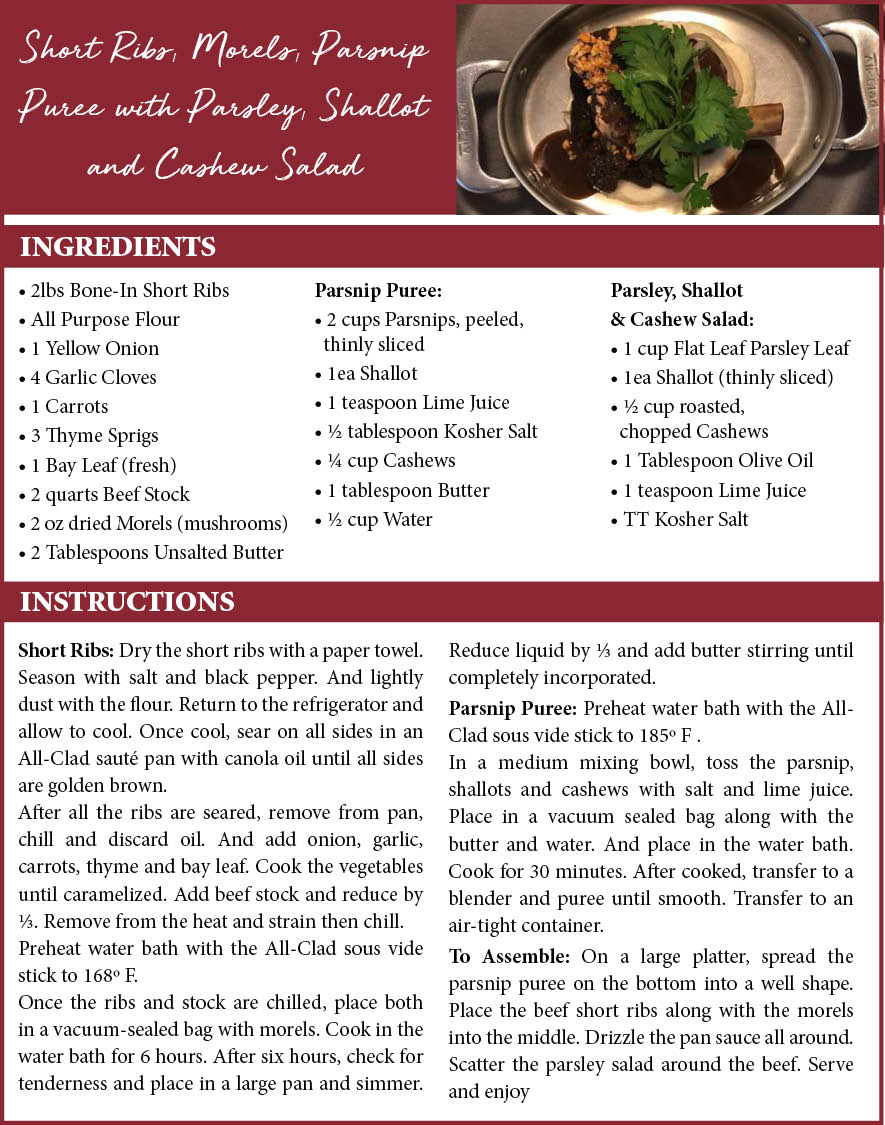
You’re My Everything
Hello my Foodie Friends!
Who doesn’t love a good bagel? Once you find that place that makes the perfect bagel, it is difficult to avoid making a bagel a regular event especially when thinking of the crusty outside and chewy interior along with the amazing flavors that are now available. Bagels are an extremely versatile and delicious item that can be eaten for breakfast, lunch or dinner. There are so many incredible ways to eat a bagel from making it with simple cream cheese, to putting chicken parmesan in a bagel for dinner to having dessert with a toasted bagel and topping it with chocolate and fluff.
Here are some fun facts about bagels: Bagel history dates back to 1783, according to popular belief. They were created to honor King John III Sobieski of Poland, after he protected Austria’s people from an attack by Turkish invaders. In the late 1800s, with an influx of Jewish immigrants, the bagel found its way over to America. Initially, they were only popular amongst Eastern European Jews who settled in New York. Around 1910, the Bagel Bakers Union was formed. This led to apprenticeships with Bagel Bakers, and thus the art spread. The Jewish bakers in Europe kept the flame going over the years by making the traditional bagel and in the late eighties, the American style bagels started to appear in Europe in a variety of flavors with a softer texture that was more suitable for sandwich making. So the round bagels have done a full circle originating in Europe and returning as an American product.
In the 1950s, the comedy, Bagels and Yox played on Broadway with bagels given to the audience in the intermission. As a result, the magazines, Time and Family Circle, began to feature recipes for bagels and they have remained popular ever since.
Bagels are the only bread that is boiled before baked. Once the bagel dough is shaped into a circle, they are dipped in boiling water for 3 to 5 minutes on each side. After that, they are drained and baked for about 10 minutes. That little hole in the center isn’t just for looks. Rumor has it the age old “role with the hole” design is rather efficient. The bagel hole comes in handy to thread multiple bagels onto a dowel, making transport easy, especially for street vendors selling the doughy delights. Believe it or not, despite the myriad bagel flavors available from blueberry to the “everything” bagel, the most popular choice is plain, followed closely by sesame.
When you are attempting to slice a bagel with a knife, you understand the difficulty, as well as the potential safety issues. You need a safe tool to easily slice bagels, Choose the NSF Certified Commercial Bagel Biter – the Original Bagel Guillotine. It is designed for heavy-duty usage made with high quality bases and guards and solid handles to prevent breakage. Never worry about cutting yourself. The guillotine blade safely slices the bagel behind the protective finger guards. It is dishwasher safe in the top rack only. This award-winning design includes non-stick coated blade that allows for easy slicing and easy cleaning. It is engineered for safety and performance. All you have to do is insert the bagel, push down, and remove the perfectly sliced bagel.
Is you mouth watering yet? There are so many delicious dishes to make with bagels. Stop by Compliments to the Chef, your neighborhood kitchen and cutlery store at 33 Railroad Place to purchase the Original Bagel Guillotine to assist you with slicing your favorite bagel. Let the one you love know that they are your “everything.” Remember my Foodie Friends: “Life Happens in the Kitchen.”
Take Care,
John & Paula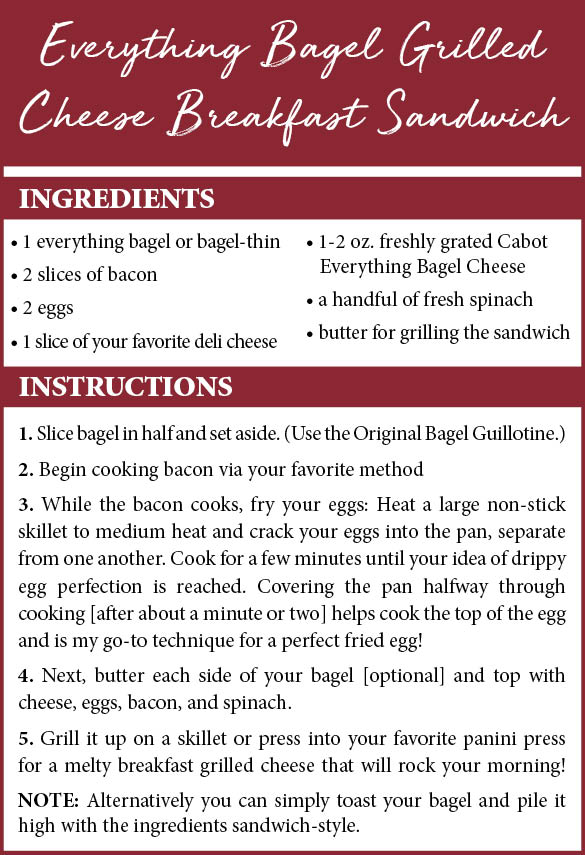
Sock It To Me
Hello my Foodie Friends!
Although it is the start to spring; we still have the chilling days and cold nights. Soup was a meal that my mother made often to serve our household of seven people (five being young children). Coming in from school in the afternoons or a day of play outside with our neighborhood kids, I could taste the soup through the aroma. A soup that is dear to my heart that evokes Italian childhood memories of my mother’s cooking is Pastina Chicken Soup. She would make her own homemade chicken broth and tiny little pasta shaped form of stars known as “pastina.” Chicken broth is a staple in most Italian households. You can rest assured that there will be a few quarts in the freezer at all times. You need a really good homemade broth to make pastina, vegetable soups, risottos, sauces, and chicken dishes pop with flavor. There was one essential item that my mother had to have to assist her with the process of making her broth, the soup sock.
You can fill these cotton mesh bags with your favorite herbs and ingredients for flavoring stocks and soups. The finely woven material holds delicate herbs or expands to accommodate everything from bones to chopped vegetables. When cooking is complete, simply remove the bag – no need for straining! They are made of strong, 100% fine cotton mesh. The soup sock comes in a large size to accommodate all sorts of flavoring ingredients, from bones and whole vegetables to herb leaves. They will not impart odors or flavors into soups or stocks. The best part is that they help with a mess-free cooking – no need for straining. The packets of soup socks come in sets of three and they are made in the USA.
Stop by Compliments to the Chef, your neighborhood kitchen and cutlery store, and pull up your socks at 33 Railroad Place and say Sock it to me! We carry cool tools for cooks. Find the items you need to assist with making your favorite soup.Remember my Foodie Friends: “Life Happens in the Kitchen.”
Take Care,
John & Paula
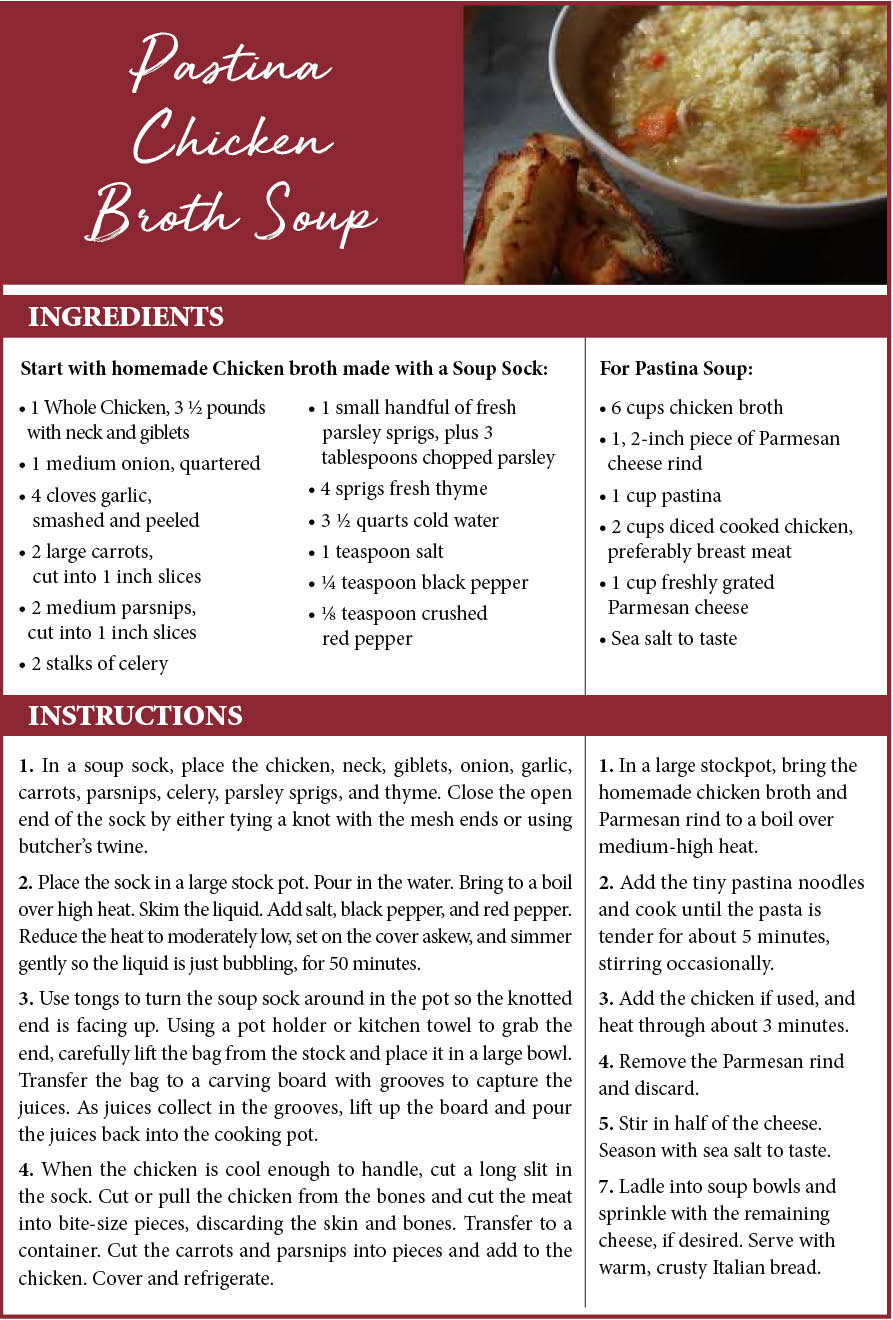
Bring on the Corned Beef & Cabbage
Hello my Foodie Friends!
This weekend is St. Patrick’s Day. My mother, who was Italian, used to say “Everyone is Irish on St. Patty’s Day.” My father, who was Irish, always agreed because if he didn’t he ran the risk of not getting her delicious Corned Beef and Cabbage. So here is to all of our “Irish” lads and lassies.
So how did Corned Beef and Cabbage become an American dish served on St. Patrick’s Day? From the Middle Ages until sometime in the 19th century, the Irish were known for producing salted meats. It was actually considered their specialty. Most of the salted meats created in Ireland were done so for trade. The salted meats were deemed too luxurious for the poor Irish, so it went out of the country and the Irish would have to resort to other measures for meaty pleasure. The closest and cheapest thing the Irish could get their hands on in terms of cured meats was salt pork — meat that’s similar to bacon. It was a staple for the Irish, and could be found in almost every home. As the Irish migrated to the United States, they couldn’t find salt pork in their new home, and bacon, the closest substitute, was insanely expensive. Thus, they turned to corned beef. It was the one thing Irish immigrants would eat in the U.S. because it reminded them of home. The truth is, most Irish folks don’t eat corned beef and cabbage nowadays. However it’s become a tradition Irish-Americans readily adopted, and welcomed as part of the Irish-American heritage we have here now.
Preparing Corned Beef and Cabbage does require some essential tools. As you look for tools to use to make your Corned Beef and Cabbage; you may need a Dutch oven or a stock pot, and a good chef (cooks knife). The chef’s knife (sometimes called a cook’s knife) is the most important knife to have in your kitchen and within your knife collection. A chef’s knife is the go-to tool for more than 90 percent of daily kitchen tasks including most slicing and dicing of fruits, vegetables, meats, and fish. And while a chef’s knife may be the “king of the kitchen,” it should not be used to butcher or carve poultry, to remove the skin of large vegetables such as butternut squash, or, as some people have tried, to puncture a hole in cans. The broadness of a chef’s knife blade makes it unwieldy for tasks better suited to a smaller knife.
Many of our customers ask me what is the best brand knife to have. Choosing a chef’s knife “is like a dance partner.” A knife that feels comfortable and graceful in your hand might feel klutzy to someone else. When you start shopping for that perfect chef’s knife—one that will make slicing, dicing, chopping, and mincing more pleasurable, precise, and effortless—it’s important to identify your personal preferences, and to realize that there isn’t one knife that’s right for everyone. Finding your ideal knife might take a little time, but you’ll know it when you’ve found it. Once you’ve got a knife in your hand you should immediately get a sense of its fit. It should feel comfortable, like a natural extension of your hand. It should inspire confidence, not instill fear. If it feels wrong, move on. If it feels pretty good; start chopping (or mock chopping), noting how you respond to the knife’s physical characteristics.
Weight: You’ll need to try several knives to find your ideal knife weight. One school of thought believes a hefty chef’s knife cuts through foods easier because it “falls” with more force. Another thinks a lighter chef’s knife flows more freely and lets you maneuver the knife more skillfully. Bottom line: Choose the style that feels right to you.
Balance: “Perfect balance” is in the palm of the beholder. Judge balance by gripping the knife by its handle. If it feels uncomfortably weighted toward the back of the handle or toward the blade, then it probably isn’t for you. An unbalanced knife will make you work harder. Side-to-side balance is also important. When you come down on the blade, the knife shouldn’t feel unstable, as if it wants to teeter toward one side or the other.
Size: An 8-inch chef’s knife is the most popular among home cooks because of its versatility. A 10-incher’s longer blade can cut more volume but may feel intimidating. A 6-inch chef’s knife can offer an element of agility, like that of a paring knife, but falls short when working with volume or when slicing through something large, like a watermelon.
As you prepare for your St. Patrick’s Day celebration events; Stop by Compliments to the Chef, your neighborhood kitchen and cutlery store, and let us help you choose the best knife for you. We carry some of the best knives made in the world. As you celebrate; be sure to compliment the chef and the host.
Remember my Foodie Friends “Life Happens in the Kitchen!”
Take Care,
John & Paula

Flash Back Friday
Hello my Foodie Friends!
What is your favorite childhood memory of food? I have so many childhood memories of eating with my family. Going out to dinner was always a rare and special treat. My father was a truck driver so he loved to travel and make a day of driving around the American landscape. We would mostly go through Vermont which is where he grew up. He loved stopping at a local diner as part of our day’s exploration.
My father loved diners! The reason is that diners are best known for their history, tradition, an extensive menu selection, large portions of comfort foods at fair prices, quick service served with diner spirit and hearty meals. Chefs and cooks showcased their occupational skill and skillet set through offering huge portions of comfort food classics, while no- nonsense but friendly waitresses served as unofficial family to customers with their welcoming ways. Locals, many with townie and patriotic tendencies, interacted through face-to-face spoken words instead of through technological devices. Truck drivers sat at the counter after long days and nights of life on the road. White collar America, some as business travelers walking briskly over from the adjacent hotel, took that well-deserved break from another anticipated day in the rat race to lighten the day with some home-cooked food. Landscapers and construction workers with clean hands, for now, were hungry, immediately decisive on what to order, and needing to get to work soon. They wasted no time ordering food while showing a close camaraderie as if they were brothers.
You see, there’s really nothing like eating at a good old-fashioned diner when traveling the small towns and back roads. The experience, quite simply, brings a wonderful slice of American tradition to the senses and taste buds that can only be fully realized by frequenting these local treasures. The diner is an icon of American culture located in almost every city and town.
Recently, I read a fun article about diners on Reminisce.com with some pretty funny diner slang that let the short order cook know what to burn, what to wreck, and what to put a hat on. It is considered “short-order shorthand.” As I read these I laughed, while bringing back memories of eating at a diner with my family.
Here is a small sampling of the article. Try to guess what the slang means before you read the answer:
Breakfast:
• Adam and Eve on a raft... » Poached eggs on toast
• Burn the British... » English muffin, toasted
• Sinkers and suds... » Doughnuts and Coffee
• Wreck’em... » Scrambled eggs
Lunch:
• Bloodhound in the Hay... » Hot dog with Sauerkraut
• Two cows, make ‘em cry... » Two burgers with onions
• First Lady... » Spareribs
Condiments:
• Axel greas... » Butter
• Paint it red... » Ketchup
• Warts... » Olives
Dessert:
• Eve with a lid on it... » Apple Pie
• Fish eyes... » Tapioca Pudding
• Houseboat… » Banana Split
• Nervous pudding… » Jello
You can make your own diner classics right in your kitchen. Make food memories with your family. My childhood memories almost always include sitting at the table eating with my four siblings, and my parents. Stop by Compliments to the Chef, your neighborhood kitchen and cutlery store located at 33 Railroad Place to help you with your family culinary needs. Remember my Foodie Friends: “Life Happens in the Kitchen.”
Take Care,
John & Paula

Life is Better with Tea
Hello my Foodie Friends!
In past articles, I have written about espresso and coffee. However, not everyone is a coffee drinker. Based on Forbes.com, the United States has had a large increase in tea drinkers with the market quadrupling during the past twenty plus years. Even Starbucks is trying to become a market leader for tea as it has been one for coffee. Tea has infiltrated most Americans’ everyday routine. Some 80 percent of U.S. households have tea in their kitchens, and more than half of the American populace drinks tea on a daily basis, according to the U.S. Tea Association.
Every culture has its own way of brewing, presenting and sharing tea. The specific tea ware used is critical to the entire process. Today I am going to focus on the Japanese cast iron tea pot and Chinese clay tea pot. The Japanese cast iron teapot is an amazing little teapot with ancient roots dating back to the 1600’s. The Japanese cast iron teapot is intended to hold the heat in, and that it does. It originates from the Japanese iron teakettle design called a tetsubin, which was often used as a teapot. This dates back to the 1600’s when iron kettles were placed on the hearth. Cast iron teapots are ideal since the cast iron distributes the heat evenly inside the pot to better extract the flavors and health benefits of your tea. A distinctively appealing taste is acquired only from brewing tea in a cast iron teapot. Cast iron teapots develop a seasoning from repeated use, producing rich flavors of tea that are each more delicious than the last.
If you’re searching for a uniquely attractive teapot then choosing a cast iron design is an excellent idea. There’s no hiding from the fact that there’s something special about brewing tea in a cast iron teapot, and the Japanese designs, in particular, tend to look truly stunning. Cast Iron Teapots are one of the best ways to prepare, serve and enjoy tea.
They come equipped with a mesh infuser for ease of use. It can be used for tea bags or loose leaf tea.
A very unique option of making tea is the Chinese clay teapot. Chinese clay teapots do not use glazing. The clay used remains porous and tea oils are intended to build up inside the teapot and over time, smooth the taste of tea and improve it by adding its own unique “taste” from the accumulated oils. Different teas are not made in the same teapot unless they are from the same family or class of teas, such as different types of green or oolongs, but even this is not ideal as some teas from the same family have a strong flavor and in time, their taste can transfer to a more delicately flavored tea. Yixing teapots are crafted from special Yixing clay, also called “Purple Sand,” which can only be sourced in the town of Yixing located in the eastern Chinese province of Jiangsu. These miraculous little teapots contain thousands of multitasking air holes (a characteristic unique to purple sand) that enhance tea brewing by keeping the water hotter longer. According to the Tea Association of the USA, these teapots are intentionally left unglazed so that they absorb the flavor of the tea being brewed, which means you may want to use one Yixing teapot for each type of tea to avoid “cross-brewing.” Yixing teapots are used to brew teas including black tea, oolong tea, pu-erh tea, green tea, and white tea. The first thing you need to do after you buy a yixing teapot is season it. Start by bringing filtered water to a boil in a pot on the stove. Gently place the yixing teapot inside the boiling water. Use a wire ladle or a white towel to create a barrier between the yixing pot and the bottom of the pan to prevent burning. Allow the yixing pot to boil gently in the hot water for 10 minutes. The next step in seasoning is to soak the pot in a strong brew of tea. Brew a strong infusion of your desired tea in the pot. Empty the infusion into a large bowl. Keep brewing infusions until the bowl has enough tea in it to submerge the yixing teapot. Place the yixing teapot in the brewed tea and let sit until the mixture reaches room temperature. Remove, pat dry and use as usual to brew tea.
At Compliments to the Chef, your neighborhood kitchen and cutlery store at 33 Railroad Place, we carry beautiful Japanese cast iron tea pots, Chinese clay pots and tea kettles. Take some time to prepare a cup of tea just for you; it can calm you down and give you a wonderfully pampered feeling. Why not take a break to enjoy a quiet cup? Remember my Foodie Friends, “Life Happens in the Kitchen.”
Take Care,
John & Paula
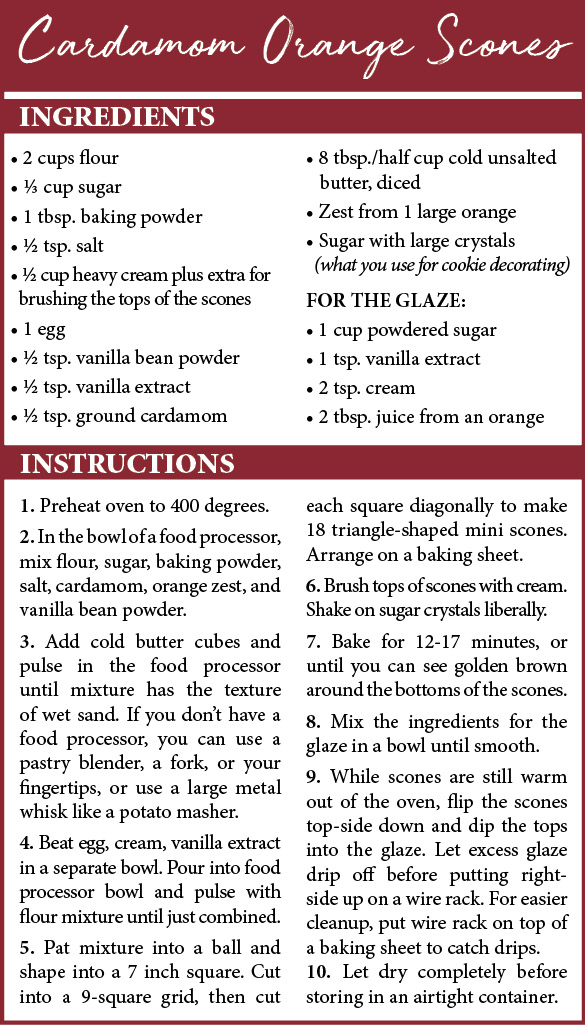
Snow Fort Army Chow
Hello my Foodie Friends!
This winter is certainly giving us a season of snow and arctic cold. As I glance out into the white wonderland, I reflect on some of my fondest childhood memories playing in the snow. I grew up during a time when the average was at least four children per household and you were literally thrown outdoors to play and told not to come back home until the street lights came on. Playing in the snow included making homemade sleds to slide down the golf course hills, making snowmen, and of course, building the best snow fort in the neighborhood. In our house we divided up the tasks to ensure that our Fort could withstand repeated attacks of snowball wielding elementary school kids. Our first winter there, Danny, 5, was the engineer and he mapped out how high and thick the walls should be. Billy, 4, was the builder and shaped the inside of the fort for the chairs, refrigerator and snow TV. Patty was 3 so the first year she was support staff. John, 6, was the recruiter and went door to door finding my soldiers and builders. We were not allowed to use the phone back then (adults only) so when I came to the door and knocked you could hear a stampede of children in the house trying to get to the door. To get them to work on the fort I would tell them that my mom was making Meatball sandwiches! My mom’s meatballs were the envy of the neighborhood and far exceeded the bologna and spam the other kids were getting. My first stops were Dave and Karl’s houses and they lived next door to each other. They were my age but already almost as tall as most of our fathers. Dave turned out to be 6’8” and Karl is 6’6”. If you want your walls to be the highest, I thought, get the tallest kids. My mom would grimace when she saw them coming as she knew she would need a lot more meatballs. Our first forts were wrecked at night by teenagers until my brother Dan came up with the idea to put water on the outside walls and it would turn them to ice. You could hear the howls of the mean teenagers when they kicked the walls and they didn’t give so easily.
Although I cannot share with you my mom’s meatball secret recipe that only my sisters and Paula have, I will share with you a special person from our area’s recipe – Rachael Ray.
At Compliments to the Chef, your neighborhood kitchen and cutlery store located at 33 Railroad Place, we carry skillets to make your meatballs in, saucepans to make your sauce, baking sheets to pop your meatball hoagies into the oven with, and other really “Cool Tools for Cooks.” Meatball Hoagies are a great way to deal with these frosty winter days. The neighborhood kids will love you! Remember my Foodie Friends: “Life Happens in the Kitchen.”
Take Care,
John & Paula
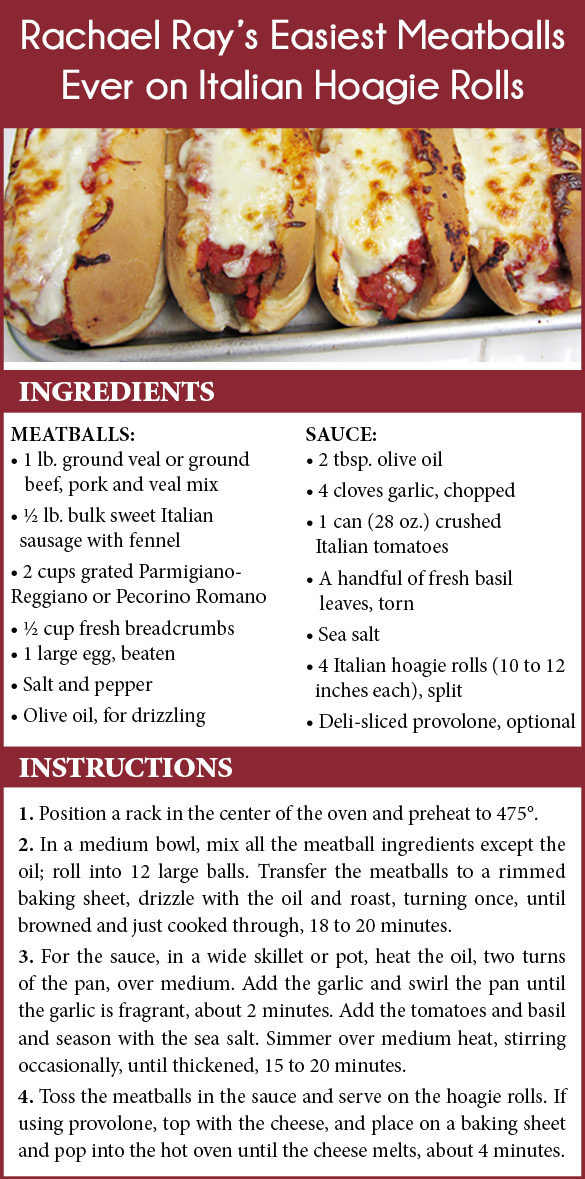
Espresso Yourself
Hello my Foodie Friends!
Flavors, taste, and smell are part of another dimension of food. Our senses allow us to create a sense of comfort and bring us back to places and time that we hold dear. I love the smell of coffee being made. Growing up with many relatives, coffee was also in the center of the kitchen table and part of the conversations that were made. As a child, I have vivid memories of my parents, aunts and uncles sitting around a table after a big meal, laughing, and having a cup of coffee or espresso in their hands. I remember Sunday evenings involved all of the adult family sitting around the table playing Pinochle, and drinking espresso (with anisette in it) while all of the children were placed in front of the TV watching the Lawrence Welk show or Judy Garland movies. In the background were the relatives yelling at each other in Italian. Along with the espresso, homemade Italian cookies were served (which all of the kids would sneak into their pockets since they we were only allowed one which was never enough). Each of my family would take bites of the wonderful sweets, sip espresso, and talk about the family. Maybe that is why I am crazy about coffee; it’s ingrained in me from childhood. There’s nothing better than the smell of espresso being brewed.
To make the espresso, our family always used a Bialetti stove top coffee pot. True coffee lovers know there’s more than one way to make a “cuppa” coffee, and they’ve tried them all: French press, drip coffee, cold brew, fancy espresso machines, and so on. One of the most humble and effective machines for making a strong cup of coffee is the stovetop espresso maker also known as the moka pot. The moka pot, or macchinetta del caffè, which literally translates to “small coffee machine,” is a stovetop machine that moves boiling water, pressurized by steam, through ground coffee to make a delicious brew. The Moka produces a rich, authentic espresso in just minutes.
The aluminum pot features Bialetti’s distinctive eight-sided shape that allows it to diffuse heat perfectly to enhance the aroma of your coffee. The story of the stove-top espresso maker begins in 1918 when Alfonso Bialetti, returned home to Italy from France, where he had been working in the aluminium industry for 10 years, and set up a workshop making metal household goods. Near his factory in Piedmont, Bialetti watched women washing their clothes in a sealed boiler with a small central pipe. The pipe drew the soapy water from the bottom of the boiler and spread it over the wet laundry. Bialetti decided to try and adapt this idea to make a coffee machine that would allow Italians to have real espresso in their homes. In 1933, an Italian inventor named Luigi De Ponti patented the design for Alfonso Bialetti, and the company is still making stovetop espresso makers with the same basic design. Bialetti’s classic moka pot is so reliable, that it remains the best stovetop espresso maker you can buy. Today, the Bialetti Moka fills many households and celebrates more than 80 years of classic design elegance and technological simplicity. The Moka Express has become iconic for the stove top espresso maker and has allowed millions of consumers to enjoy great Italian coffee.
Making stovetop espresso:
1. Rinse the pot out with hot water, including the underside of the ‘jug’ part of the pot where coffee grounds will stick to the filter.
2. Make sure the threads on the jug and the reservoir section are clear of grounds, or the two parts of your pot won’t join properly and your pot can start to spit and hiss when it’s on the stove.
3. Fill the reservoir with water up to the fill-line. If your pot doesn’t have a fill-line, or you can’t see it, fill the reservoir to about half an inch below the safety valve.
4. Place the basket in the reservoir and spoon coffee grounds into it. You want the coffee to be quite loose, so don’t tamp it down – coffee expands when it gets damp, so it needs a bit of room to do this. Fill the basket about three-quarters full.
5. Screw the jug part of the pot back onto the base, and put the pot on a low heat on the hob. If you turn up the heat too high, the coffee will boil in the pot and taste bitter.
6. The Moka Pot takes about five minutes or so to make the coffee. Many people recommend taking the pot off the heat as soon as it starts to make gurgling noises, but if you use a very low heat, you may find that removing the pot too soon leaves the reservoir half full and the pot half empty. Using a low heat means that the coffee never boils, so you won’t have to worry about the coffee tasting bitter.
At Compliments to the Chef, your Neighborhood Kitchen and Cutlery store located at 33 Railroad Place, we carry both the Bialetti Moka Espresso pot and Bialetti stainless steel pot. The stainless steel stove-top pot has a sleek contemporary design with ergonomic heat resistant handles. You can use these pots anywhere. Take them on vacation, camping trips, or to a friends’ house. As I sit and have my morning cup of coffee or espresso, those incredible memories of family members past and present bring me back to a time that was precious. Remember my Foodie Friends; “Life Happens in the Kitchen,” at the kitchen table playing, talking, and sharing with each other.
Take Care,
John & Paula

Language of Food
Hello my Foodie Friends!
Guess what weekend this is: Yes, it’s the weekend before Valentines Day and I know the quickest way to someone’s heart is great cooking. There is nothing more impressive than whipping up a romantic meal for your partner. It is food that creates a home, connections, celebrations, and embraces family and friends. In creating meals, we are creating homes and a nurturing environment. The meals do not have to be fancy or gourmet. It isn’t about how special the recipe is. It is about being conscious of an important part of life and honoring that importance. By elevating the importance of food in our family’s lives, you pass that importance on to them. Families connect around the dinner table, all sharing the meal they know is just for them. They also learn the subtle ways you can say “I love you.” through the daily care of mealtime.
Among my dearest things to do on Valentines Day is to watch one of my favorite Disney movies “Lady and the Tramp” and having Spaghetti and Meatballs as our romantic dinner. As one of the greatest love stories ever told, “Lady and the Tramp” is sure to melt the hearts of generations with its beloved characters, brilliant animation, memorable music and sweet sentiment. The animated treasure tells the story of Lady, a lovingly pampered cocker spaniel, and Tramp, a freewheeling mutt with a heart of gold. The best part is the creative, tender, iconic and downright romantic moment when the cocker spaniel and the schnauzer-mix in Lady and the Tramp serendipitously pull each other into a kiss when they slurp up the same noodle from a plate of spaghetti. It’s their first official date, it’s under a starry sky, there’s music, and they’re both completely oblivious about what’s about to happen until the very last moment when their lips touch!
At Compliments to the Chef, your neighborhood kitchen and cutlery store, we have several items by All-Clad that can assist with making your Valentine’s Dinner; the 6 Quart Pasta Pot with 6 quart pot and perforated pasta draining insert; or the 8 Quart or the 12 Quart Multi Cooker that includes a steamer basket and a perforated pasta draining insert. The large pot works well for canning, blanching, or making large batches of soups, sauces, and stews. With the perforated insert in place, the multi cooker conveniently prepares homemade stocks, vegetables, or pasta—simply lift the insert to instantly drain. Prominent side handles ensure a secure hold when transporting the pot from the sink to the stovetop or when lifting the insert. The included steel steamer basket fits inside the insert for cooking delicate foods like vegetables or seafood.
Our prescription for a perfect evening? Whip up a pot of spaghetti and meat balls, light a few candles, pop in “Lady and Tramp,” and snuggle up with someone you love – whether it’s Mr. or Ms. Right, or the whole family – and enjoy a little “Bella Notte” of your own. Finish with something sweet and a goodnight kiss. Show your love through the foods you cook. Stop by Compliments to the Chef located at 33 Railroad Place and let us know how we can help you with your culinary needs. Remember my Foodie Friends; “Life Happens in the Kitchen.”
Take Care,
John & Paula
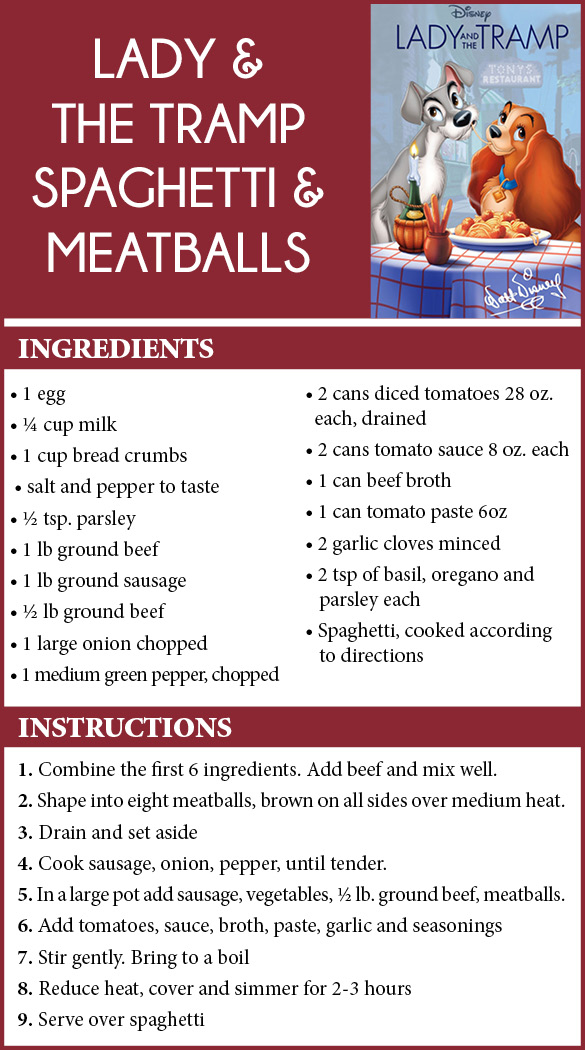































 How to resolve AdBlock issue?
How to resolve AdBlock issue? 









